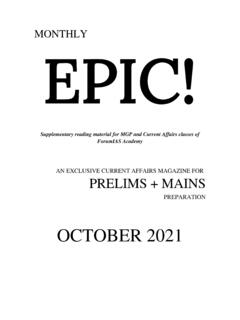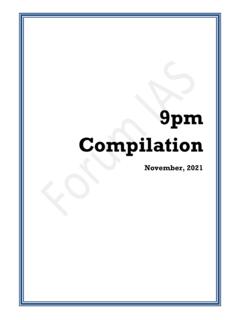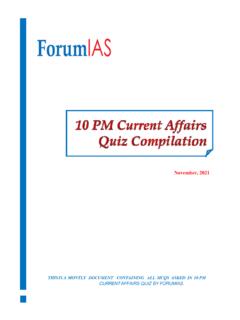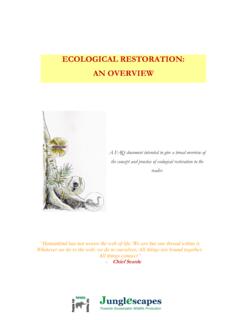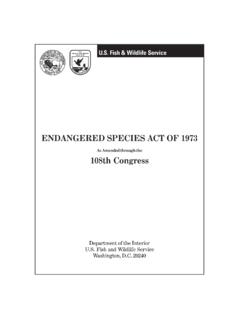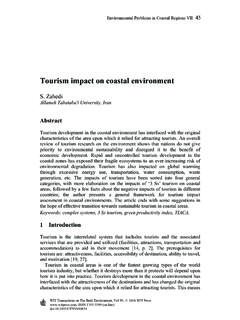Transcription of Environment - ForumIAS Blog
1 Environment RED BOOK | PT Things 2021 1st Edition | For feedback email us : This Red Book is a part of a Supplementary Study Material for ForumIAS Academy Comprehensive Guidance Program ( CGP) 2022. ForumIAS Academy, 19, IAPL House, PUSA Road, Karol Bagh 110005, New Delhi | | To Download study material visit : | 9821711605. Dear Friends, We have finally come out with the first version of the Environment Red Book [ PT Things ]. For years we had been longing for a good book on Environment given the high weightage accorded to the subject in the Civil Services Preliminary Examination. The first edition of the Environment Red Book [PT Things] is dedicated to the ForumIAS Community and the wonderful members that make it up. We look forward to your suggestions, feedback and fresh and new ideas. You can reach us at - Neyawn This Red Book is a part of a Supplementary Study Material for ForumIAS Academy Comprehensive Guidance Program ( CGP) 2022. ForumIAS Academy, 19, IAPL House, PUSA Road, Karol Bagh 110005, New Delhi | | To Download study material visit : | 9821711605.
2 1. Table of Contents CHAPTER 1 .. 5. Environment .. 5. ECOLOGY .. 5. FUNCTIONS OF ECOSYSTEM .. 8. Ecological Succession .. 8. Energy Flow Through an Ecosystem .. 9. Bio-geo-chemical cycle .. 13. TERRESTRIAL AND AQUATIC ECOSYSTEMS .. 16. Terrestrial Ecosystem .. 16. Aquatic Ecosystem .. 19. CHAPTER 2 .. 25. ENVIRONMENTAL POLLUTION .. 25. Air Pollution .. 25. Water Pollution .. 27. Noise Pollution .. 29. Radioactive Pollution .. 29. 29. Plastic Pollution .. 29. Soil Pollution .. 30. General pointers .. 31. ENVIRONMENTAL ISSUES .. 31. Sand Mining in India .. 31. Other issues .. 32. CHAPTER 3 .. 33. CHAPTER 4 .. 35. RENEWABLE ENERGY .. 35. Solar Energy .. 35. Wind Energy .. 36. Hydro power .. 37. Other forms of renewable energy .. 37. CHAPTER 5 .. 41. Indian 42. Landscape Biodiversity .. 42. Fauna .. 43. Flora .. 45. IUCN Red Data Book .. 47. Schedule Animals of Wildlife Protection Act 1972 (WPA) .. 50. Animal Diversity of India .. 54. Marine 56. CHAPTER 6.
3 58. Project Tiger .. 58. Project Elephant .. 59. This Red Book is a part of a Supplementary Study Material for ForumIAS Academy Comprehensive Guidance Program ( CGP) 2022. ForumIAS Academy, 19, IAPL House, PUSA Road, Karol Bagh 110005, New Delhi | | To Download study material visit : | 9821711605. 2. Vulture 59. Sea Turtle Project .. 60. Project Hangul .. 60. Captive Breeding .. 60. Biodiversity Conservation Measures .. 60. Miscellaneous .. 61. Biosphere Reserves .. 63. Biodiversity 64. Biodiversity Coldspots .. 64. World Heritage Sites .. 64. Eco-Sensitive Zones (ESZ)/Eco-Sensitive Areas (ESA) .. 64. CHAPTER 7 .. 66. Environmental Legislations .. 66. Wildlife Protection Act, 1972 .. 66. Environment (Protection) Act, 1986 .. 67. Biological Diversity Act, 2002 .. 67. The Scheduled Tribes and Other Traditional Forest Dwellers (Recognition of Forest Rights) Act, 2006 .. 68. National Forest Policy, 69. Coastal Regulation Zone (CRZ) .. 69. Wetland (Conservation and Management) Rules, 2017.
4 70. Solid Waste Management Rules, 2016 .. 71. Hazardous and Other Wastes (Management and Transboundary Movement). Amendment Rules, 2019 .. 71. Construction and Demolition Waste Management Rules, 2016 .. 71. Bio-medical Waste Management Rules, 2016 .. 72. E-Waste Management Rules, 2016 .. 72. Plastic Waste Management Rules, 2016 .. 72. Miscellaneous .. 73. Institutional Measures .. 74. National Afforestation and Eco-Development Board .. 74. Compensatory Afforestation Fund Management and Planning Authority (CAMPA) .. 74. National Clean Energy Fund .. 74. Forest Survey of India (FSI) .. 74. Botanical and Zoological Survey of India .. 74. Central Ground Water Authority (CGWA) .. 75. Central Water Commission (CWC) .. 75. Animal Welfare Board of India .. 75. Central Zoo 75. National Biodiversity Authority .. 76. Wildlife Crime Control Bureau (WCCB) .. 76. Wildlife Trust of India (WTI) .. 76. National Board for 76. Other Government 76. Miscellaneous .. 77.
5 This Red Book is a part of a Supplementary Study Material for ForumIAS Academy Comprehensive Guidance Program ( CGP) 2022. ForumIAS Academy, 19, IAPL House, PUSA Road, Karol Bagh 110005, New Delhi | | To Download study material visit : | 9821711605. 3. CHAPTER 8 .. 79. Global 79. Ocean Acidification .. 81. Ozone Depletion .. 81. Climate Change Mitigation 83. Carbon Capture and Storage .. 83. Carbon Sink .. 83. Carbon Credit .. 83. Carbon Offsetting .. 84. Carbon Pricing .. 84. Geo-engineering .. 85. India and Climate 85. National Action Plan on Climate Change (NAPCC) .. 86. Indian Network on Climate Change Assessment (INCCA) .. 89. Labelling Program for Appliances .. 89. Energy Conservation Building Code (ECBC) .. 90. Electric Vehicles .. 91. National Initiative on Climate Resilient Agriculture (NICRA) .. 92. National Adaptation Fund for Climate Change (NAFCC) .. 94. CHAPTER 9 .. 95. International 95. United Nations Conference on Environment and Development (UNCED).
6 95. Ramsar Convention .. 98. CMS (Convention on the Conservation of Migratory Species) .. 98. CITES (Convention on International Trade in Endangered Species of Wild Flora and Fauna) .. 99. Vienna Convention .. 100. Minamata Convention .. 100. Rotterdam Convention .. 101. Basel Convention .. 101. Stockholm Convention .. 102. International Organizations .. 103. TRAFFIC .. 103. International Tropical Timber Organization (ITTO) .. 103. 103. Global Tiger Forum (GTF) .. 103. International Whaling Commission (IWC).. 103. Other Global Initiatives .. 104. CHAPTER 10 .. 106. Conference of Parties (COP).. 106. Kyoto Protocol (COP 3; UNFCCC Summit 1997) .. 106. Parties under the Kyoto Protocol .. 107. Flexible Market Mechanisms .. 107. Important UNFCCC Summits post Kyoto .. 108. CHAPTER 11 .. 112. This Red Book is a part of a Supplementary Study Material for ForumIAS Academy Comprehensive Guidance Program ( CGP) 2022. ForumIAS Academy, 19, IAPL House, PUSA Road, Karol Bagh 110005, New Delhi | | To Download study material visit : | 9821711605.
7 4. Green Economy .. 112. Sustainable Development .. 114. Global Environment Facility (GEF) .. 114. Green Climate Fund (GCF) .. 115. Global Climate Finance Architecture .. 115. 117. APPENDIX .. 120. 1. Tiger Reserves .. 120. 2. Elephant Reserves .. 121. 3. Biodiversity Heritage Sites in India .. 122. 4. Biosphere Reserves .. 123. 5. World Network of Biosphere Reserves (WNBR) .. 125. 6. Sacred Groves .. 125. 7. Natural World Heritage Sites .. 125. 8. Mangrove sites in India .. 126. 9. Marine National Park and Wildlife Sanctuaries .. 127. 10. National Parks and Wildlife Sanctuaries in news .. 127. 11. Ramsar sites .. 129. 12. Reports and 131. This Red Book is a part of a Supplementary Study Material for ForumIAS Academy Comprehensive Guidance Program ( CGP) 2022. ForumIAS Academy, 19, IAPL House, PUSA Road, Karol Bagh 110005, New Delhi | | To Download study material visit : | 9821711605. 5. CHAPTER 1. Environment , ECOLOGY AND ECOSYSTEM. Environment . Environment means anything that surrounds us.
8 It consists of both living (biotic) and non-living (abiotic) things. Interactions among the biotic and abiotic components shape the habitat and ecosystem of an organism. The Environment includes the physical (air, water), chemical (carbon cycle, nitrogen cycle) and biological (biomolecules, organisms) interactions that affect an organism. Components of Environment Abiotic Biotic Water Green plants Soil Non-green plants Atmospheric gases Man Fire Animals Energy Parasites Temperature Decomposers ECOLOGY. Ecology is the study of relationships between living organisms, including humans and their physical Environment . There are five main levels of organization of ecology. Ecological Organization Population refers to a group of individuals usually of the same species, occupying a defined area during a specific time. Community refers to all populations of different species that live in the same area and interact with one another. A community is composed of all of the biotic factors of a site.
9 Communities in most instances are named after the dominant plant form and can be divided into two types: a. Major Community- These are large-sized and relatively independent. They depend only on the sun's energy from outside. , Tropical Evergreen Forests. b. Minor Community- These are dependent on the neighboring communities. , A mat of lichen on a cow dung pad. Ecosystem is the structural and functional unit of a biosphere. It consists of a community of living organisms in conjunction with their Environment 's non-living components, both interacting and exchanging materials between them. This Red Book is a part of a Supplementary Study Material for ForumIAS Academy Comprehensive Guidance Program ( CGP) 2022. ForumIAS Academy, 19, IAPL House, PUSA Road, Karol Bagh 110005, New Delhi | | To Download study material visit : | 9821711605. 6. Some terms to remember: 1. Autotrophs -Primary producers like green plants, microscopic algae. 2. Heterotrophs/Phagotrophs- Consumers who are incapable of producing their own food, , humans.
10 3. Saprotrophs/Osmotrophs- They are decomposers like bacteria, fungi, earthworms. Ecotone is a zone of junction between two or more diverse ecosystems. , the mangrove forests are an ecotone between marine and terrestrial ecosystems while grasslands represent an ecotone between forest and desert. Other ecotones are estuary and riverbank. Important characteristics of ecotone are: a. It is a zone of tension with conditions intermediate to the ecosystems bordering it. b. It is linear as there is a progressive increase in species composition of incoming community and simultaneous decrease in species of outgoing adjoining community. c. There may be organisms in an ecotone entirely different from that of adjoining communities. d. Ecotones may have an edge effect' wherein the number of species and population density of some species in this zone is much greater than either community. Niche refers to the unique functional role or place of a species in an ecosystem.
